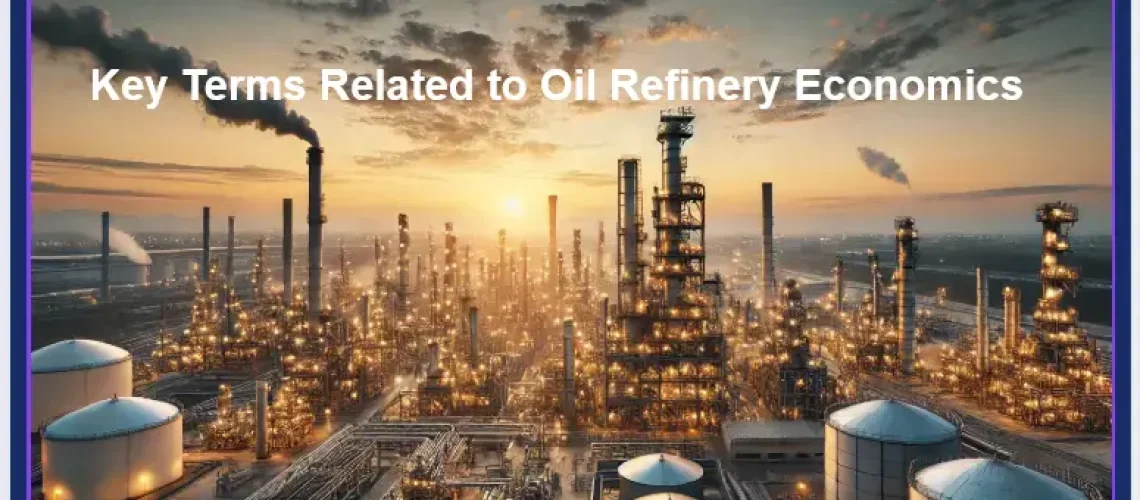A Comprehensive Guide to Petroleum Refinery Economics for Professionals
The success of a refinery depends on optimizing costs, maximizing product yields, and responding effectively to market dynamics. Understanding key economic principles and applying them with data-driven decisions is crucial for professionals managing refineries. This guide covers theoretical concepts and practical calculations to help refine your economic strategies.
1. Feedstock Costs
Feedstock, usually crude oil, is the largest cost in refining. Crude oil prices are influenced by geopolitical events, supply-demand dynamics, and market speculation. Refineries that can process a wider range of crude grades (light, heavy, sweet, or sour) can reduce costs by purchasing cheaper grades.
Crude oil prices depend on type (light/sweet or heavy/sour) and market conditions. For high profits invest in units to process cheaper heavy/sour crude grades to lower costs.
More about crude oil types and properties please view the Category page at www.thepetrosolutions.com
Crude Oil Types and Properties – www.thepetrosolutions.com
2. Refining Margins
Refining margins are calculated as the difference between the value of refined products and crude oil costs.
Gross Refining Margin (GRM)
Calculated as the total revenue from refined products minus the cost of crude oil, excluding operational expenses. GRM=Total Revenue from Refined Products−Cost of Crude
Example Calculation:
A refinery sells refined products worth $55,000,000. Crude oil cost is $40,000,000.
- GRM = $55,000,000 − $40,000,000 = $15,000,000.
Net Refining Margin
- GRM minus operating costs; NRM=GRM−Operating Costs
- Operating costs are $5,000,000.
- NRM = $15,000,000 − $5,000,000 = $10,000,000.
3. Crack Spread: Refinery Market Indicator
Crack spread shows profitability based on refined product prices and crude oil costs. wider crack spread indicates higher refining margins and profitability. The 3:2:1 crack spread assumes 3 barrels of crude oil yield 2 barrels of gasoline and 1 barrel of diesel.
Example Calculation:
- Crude Oil Price: $80/barrel.
- Gasoline Price: $120/barrel.
- Diesel Price: $110/barrel.
- Crack Spread= ((2×120+1×110)/3) − 80
- Crack Spread = (240+110)/3−80 = 36.67 per barrel.
4. Products Yields
Yield in petroleum refining refers to the percentage or quantity of refined products (e.g., gasoline, diesel, jet fuel) obtained from a specific volume of crude oil after processing. Yields represent the efficiency of converting crude oil into products.
Example Calculation:
From 1 barrel (42 gallons) of crude oil, a refinery produces:
- Gasoline: 20 gallons (47.6%).
- Diesel: 15 gallons (35.7%).
- Other products: 7 gallons (16.7%).
Total Yield = 47.6%+35.7%+16.7%=100%
5. Product Slate
Product Slate refers to the specific mix of refined products that a refinery produces from processing crude oil. Refineries adjust the product slate to maximize output of high-demand products. By optimizing the slate to match profitable products (e.g., gasoline during summer), refineries maximize their refining margins. The product slate reflects the strategic allocation of those products based on market and operational factors.
For a typical barrel of crude oil (42 gallons):
- Gasoline: 19 gallons (~45%)
- Diesel: 11 gallons (~26%)
- Jet Fuel: 4 gallons (~10%)
- Liquefied Petroleum Gas (LPG): 2 gallons (~5%)
- Residual Fuel Oil and Others: 6 gallons (~14%)
Note: The exact product slate varies based on crude oil quality, refinery type, and market demand.
6. Capacity Utilization
Capacity utilization in a petroleum refinery refers to the percentage of the refinery’s total processing capacity that is being used over a specific period. It is a key indicator of operational efficiency and economic performance.
Example Calculation:
A refinery with a capacity of 1,000,000 barrels/month processes 800,000 barrels.
Capacity Utilization = 800,000/1,000,000×100=80%
7. Energy Efficiency
Energy efficiency measures how effectively the refinery uses energy to process crude oil into refined products. It measures the energy required to process crude oil. Electricity, natural gas, steam, and fuel oil used for powering equipment and processes.
- Energy-efficient refineries typically consume 0.12–0.15 MWh/barrel.
- Less efficient refineries may exceed 0.20 MWh/barrel.
Example Calculation:
A refinery consumes 1,500 megawatt-hours (MWh) of energy to process 10,000 barrels.
Energy Efficiency = 1,500/10,000=0.15 MWh/barrel
8. Break-even Price
The break-even price in a petroleum refinery is the crude oil price at which the refinery’s total cost of operations equals the revenue from selling its refined products. At this price, the refinery neither makes a profit nor incurs a loss.
9. Turnaround Costs
A turnaround in a petroleum refinery is a planned, scheduled shutdown of operations for maintenance, inspection, repairs, and upgrades to ensure the refinery operates efficiently and safely. Turnaround costs refer to the total expenses incurred during this period, including lost production, labor, materials, and equipment.
10. Nelson Complexity Index
The Nelson Complexity Index (NCI) measures the complexity of a refinery. Higher NCI indicates greater ability to process heavy crudes and produce high-value products. The Nelson Complexity Index measures the secondary conversion capacity of a petroleum refinery by comparing it with the primary distillation capacity. The complexity index provides an easy metric for quantifying and ranking the complexity of various refinery units.

Example:
- A simple refinery has an NCI of 5, processing light crude into basic products.
- A complex refinery with hydrocrackers and cokers has an NCI of 12, allowing flexibility to process cheaper heavy crude and maximize product value.
Top References
- Petroleum Refinery Process Economics by Robert E. Maples
- Canadian Fuels Association: The Economics of Petroleum Refining
- U.S. Energy Information Administration (EIA)
- Nelson Complexity Index For Petroleum Refineries www.thepetrosolutions.com





